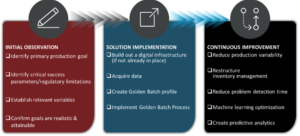Golden Batch Manufacturing: A Golden Opportunity
Today we want to explore the mechanics of manufacturing and when to know if it's right for your organization to implement Golden Batch manufacturing. Control Global defines a Golden Batch as “the time-based profile of the measurement values that were recorded for a particular batch that met product quality targets."
Simply put, it is a system for identifying an ideal output and optimizing the manufacturing process to replicate the conditions that produced it.
When applied to a manufacturing process, Golden Batch yields two primary benefits:
- Reduction in costs
- Increase in revenue
Cost reduction is primarily achieved through improving yield; yield improvements are driven by increased resource utilization and reductions in waste, unplanned downtime, out-of-tolerance process conditions, audits and recalls. An increase in revenue is achieved through increased product quality and manufacturing consistency, thus creating market differentiation. Golden Batch also decreases lead times, enabling greater customer satisfaction and market penetration.
Another advantage of Golden Batch is that it is easy to implement and easy to use – often, existing data is leveraged to build out an initial Golden Batch profile. After implementation, Golden Batch can help formalize an operational focus on continuous improvement as it lays the foundation for data-driven operating procedures. While it is initially reactionary, using historical data to identify ideal manufacturing conditions, Golden Batch can start a company on a journey toward preventative analytics.
Contrary to popular belief, Golden Batch does not only apply to batch manufacturing in the food and beverage industry. Any batch process within chemicals, oil and gas, or any other process industry can be an ideal candidate if it is in a mature lifecycle state. The process only requires a stable supply chain with moderately consistent product inputs that have simple, causal relationships with finished product quality.
Golden Batch can be deployed with a three-phase approach:

To demonstrate the Golden Batch process, consider a case study featuring a global food and beverage leader manufacturing a “Golden” tortilla. The case study details each implementation phase as well as descriptions of the application and the tortilla manufacturing process.
Initial Observation
The first step to applying Golden Batch is identifying the processes and ideal production quality output. Critical success parameters should be investigated to determine the boundaries and scope of the project, including associated regulatory limitations and costs. Other crucial factors are identifying the variables that are currently impacting production quality and confirming that there are sensors or other tools to monitor the data. Both are vital for setting a realistic and attainable timeline.
For the tortilla manufacturer, an initial analysis showed that the company’s infrastructure was already equipped with tools to collect data. A farinograph, which measures shear rate and viscosity, was identified as the key output sensor to determine batch success. The company had existing research that determined farinograph values for an ideal batch. The line was evaluated to have fifty-five measurable variables that could influence the batch outcome.
Solution Implementation
The activities included in the implementation phase depend on the availability of historical process data. If historical data exists, that data should be cleansed, organized, and migrated to begin building the Golden Batch profile. If historical data does not exist, a digital infrastructure must be built before building the Golden Batch data profile. This requires additional time and resources to ensure there is complete data collection to support the analysis. In either case, the goal is to build a comprehensive data set of process inputs and the corresponding product quality which can then be analyzed to reveal causal relationships. This analysis will yield a quantity of input parameters that are highly influential to end-product quality. These findings, along with a company’s manufacturing process expertise, will provide a deep understanding of the manufacturing process. By focusing only on input parameters that heavily influence end-product quality, the time to process and optimize the Golden Batch profile will be minimized.
In the case of the tortilla manufacturer, the line’s sensors had collected a one-year set of historical performance data. The data was analyzed and filtered down to only those manipulatable variables that had a significant influence on the farinograph readings. A custom predictive model was constructed using all twenty-one of these variables.
The Golden Batch optimization algorithm determined the “best available” combination of variables to reach the target farinograph value. This new insight indicated to the company why and how to change their manufacturing process to produce tortillas most optimally.
Applying Golden Batch resulted in the following positive outcomes for this manufacturer:
- 72.7% reduction in error from the current batch formulation model to the optimized Golden Batch model
- 6.6% improvement in median product quality
- Minimum 27% quality improvement towards the target metric in 5.5% of the lowest-quality final products
Beyond realizing significant improvements to product quality and consistency, Golden Batch can also reduce revenue lost due to scrap and other waste sources, increase overall equipment effectiveness (OEE), ensure regulatory compliance, and improve customer satisfaction.
Continuous Improvement
Unlike the implementation phase, continuous improvement of the Golden Batch profile need not be sequential. Over time, continuous improvement activities optimize the Golden Batch profile, yielding more and more value to manufacturers. Continuous improvement is goal-driven, ensuring each batch iteration replicates the conditions required for an ideal output. Over time, the information and insights gathered can be used to understand other parts of the manufacturing process or as inputs to complex autonomous batch modeling solutions utilizing machine learning and model predictive control.
At the tortilla manufacturer’s production facility, the results from the Golden Batch implementation served as a pathway to continuous improvement into the future. This led them towards predictive analytics and predictive maintenance and will eventually pave the way for the use of model predictive control, the next natural step to an autonomously updated batch model.
Is Golden Batch Right for You?
When considering Golden Batch for your manufacturing process, there are three key criteria that can make the process more likely to succeed.
- Consistency: Golden Batch works best in static manufacturing environments with consistent inputs. It is an impractical solution to apply to manufacturing processes with constantly changing input or output conditions that would require frequent alterations. For processes that fall outside of ideal conditions for Golden Batch, model predictive control is recommended. Model predictive control is an autonomous modeling solution to drive consistent quality products through complex and changing input variables.
- Expert Insight: While Golden Batch can provide insight into critical process parameters and variables, it does not connect to automation systems for actuation or input parameter adjustment. After the influential variables are identified, vetting by a company's process experts will confirm that the relationships are, in fact, causal. Making process changes as a result of Golden Batch insights will remain the responsibility of manufacturing experts. After significant relationships are determined and verified over time, the solution can evolve to integrate with some closed-loop control systems.
- Architecture: Implementing and achieving results from a Golden Batch solution can become increasingly time- and resource-intensive if the necessary sensing, control, and data storage infrastructure is not in place. Prior to investing in Golden Batch, ensure that manufacturing process data can be accessed and organized in a usable format for a Golden Batch profile.
Laying the Foundation for Golden Batch Manufacturing
If your manufacturing process and related infrastructure meet the criteria above, you may determine that Golden Batch is the right solution to apply to your manufacturing process. It is a powerful tool that leverages existing data to provide new insights, enabling you to achieve and maintain optimal product quality and in turn reduce costs, increase revenue and improve customer satisfaction.



